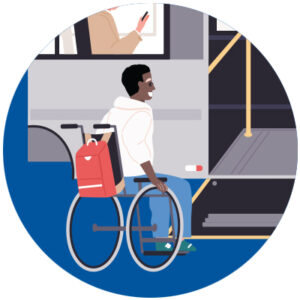Greg Bamber knows the feeling of being on the wrong side of the door. He was only 50 when a fall off a roof resulted in a spinal cord injury. With a wife and two teenage daughters, he faced a new life that impacted them all. “I think my accident helped my youngest find her calling in life. She’s a Registered Nurse now” says Greg.
Being a former industrial mechanic, he was used to figuring out what was wrong and how to fix it. While he couldn’t fix the damage done to his body, he soon learned that exercise and physiotherapy could help. The problem was that often the community resources that were supposed to be for the whole community were not accessible. Public pools and weight rooms in local community centres did not meet the needs of the disability community. So with the same fix-it attitude that he used to approach machinery, he went to work on fixing the issue.
Joining the Accessibility Committee in the City of Oshawa he worked on ensuring that accessibility and universal design were incorporated in many of the new facilities that were being built. Seeing the pool lifts and range of motion equipment at his local community centre was a proud moment. He says, “At the time Oshawa was the fastest growing community in the province so accessibility came easy sometimes.”
Greg takes a pragmatic approach to accessibility. He recognizes that not every business can invest the thousands of dollars it would take to be totally accessible. Retrofitting older buildings is difficult and costly and many businesses can’t afford it. But there are things they can do to make it easier.
Then when his wife retired, they decided to move to his hometown of Brockville. It was the right choice for them because it was near their cottage and family, which now includes five grandchildren. However, Greg soon discovered that accessible infrastructure was lacking in the smaller and older community. No accessible taxis, and few accessible parking spaces meant getting around town was not easy. But Greg was not going to stay home and let the challenges keep him behind his door. Visibility is key to making changes. ”I think the biggest thing a person can do is get out in the community and make yourself known,” he says. “I go to the YMCA, I do my grocery shopping. I talk to people and they see me living my life.”
 Working with the town council to build awareness of the need for accessible transportation, like paratransit and accessible taxis is beneficial for the whole community. Brockville is a pretty tourist town on the St. Lawrence, but without accessible transportation, a person’s visit could end at the train station. The town is making strides to make things better, and it stands as a good example to other municipalities.
Working with the town council to build awareness of the need for accessible transportation, like paratransit and accessible taxis is beneficial for the whole community. Brockville is a pretty tourist town on the St. Lawrence, but without accessible transportation, a person’s visit could end at the train station. The town is making strides to make things better, and it stands as a good example to other municipalities.
Greg takes a pragmatic approach to accessibility. He recognizes that not every business can invest the thousands of dollars it would take to be totally accessible. Retrofitting older buildings is difficult and costly and many businesses can’t afford it. But there are things they can do to make it easier. Greg is starting a campaign he calls “Get Me Through the Door”. He wants to encourage business owners to make whatever changes they can to be more accessible even if it doesn’t meet the full accessibility requirements. “Maybe they can’t afford the $10,000 for an automated door. They can put in a doorbell so I can let you know I need help getting in.” A simple ramp can go a long way to helping people do business with you.
Within his social network, Greg has people who have taken measures to welcome him to their homes. He has two friends who made it possible for him to visit. One has installed a porch lift, and the other has made a ramp so Greg can enter their homes. They took action to ensure he could “get through the door,” and he knew those doors were always open for him.






